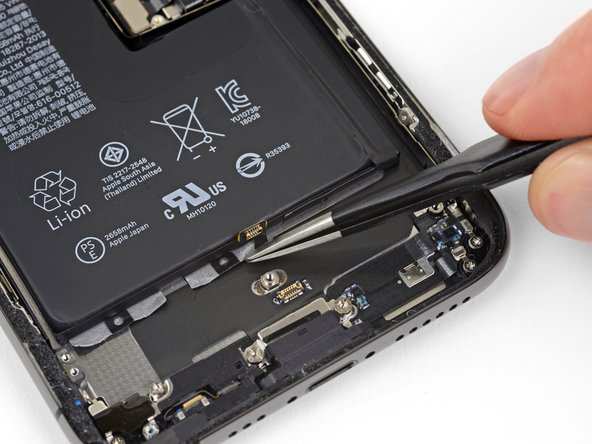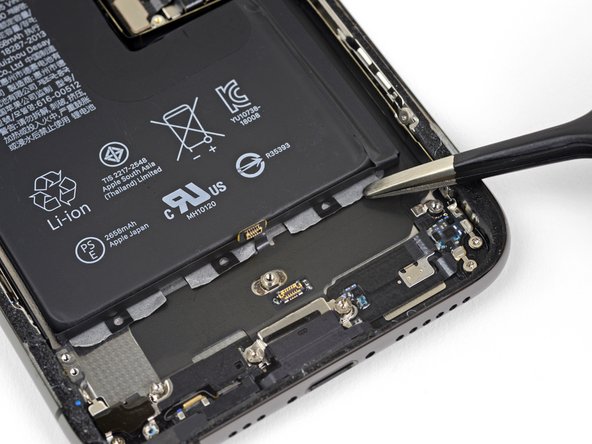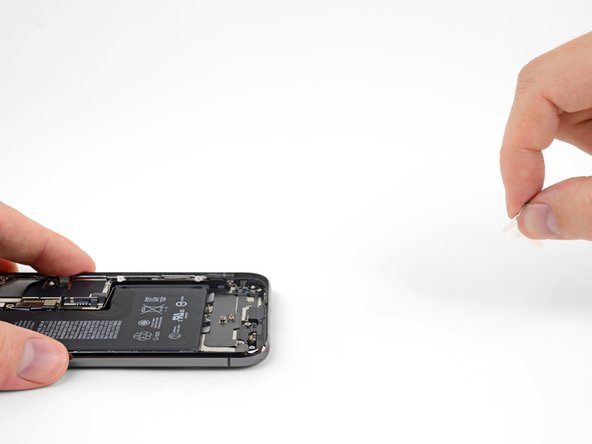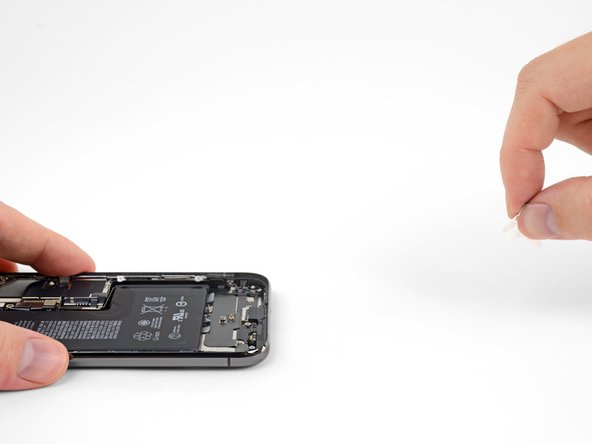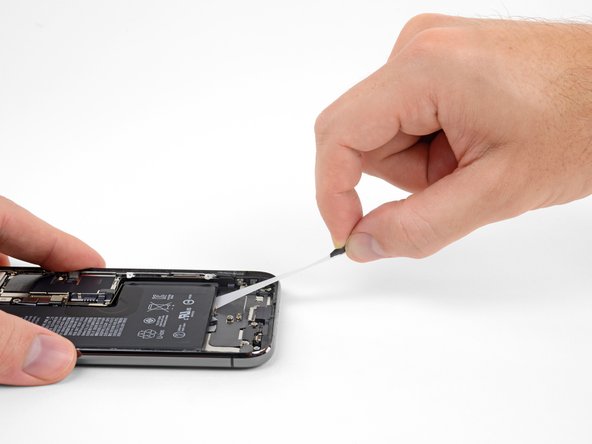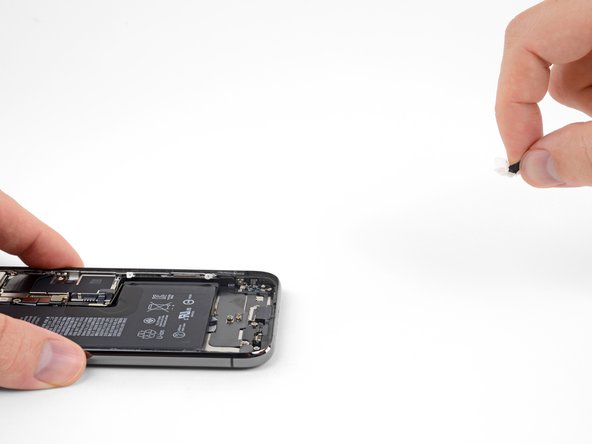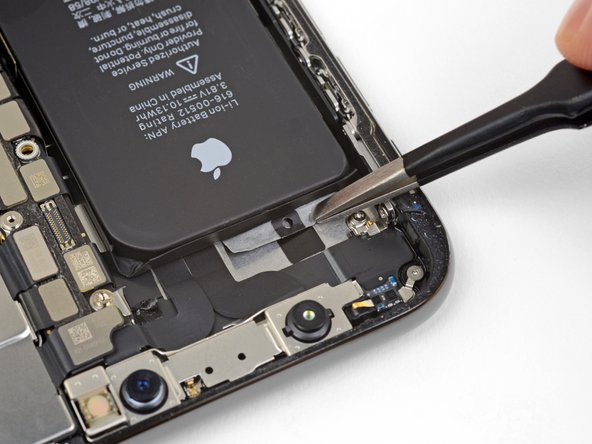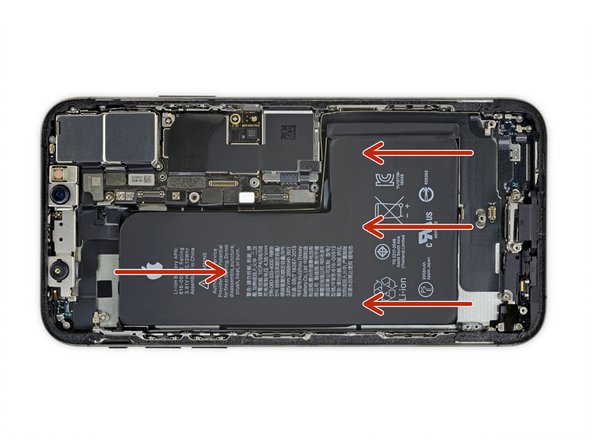Esta versão pode conter edições incorretas. Mude para o último instantâneo verificado.
O que você precisa
Vídeo de Apresentação
-
Este passo não foi traduzido. Ajude a traduzi-lo
-
Power off your iPhone before beginning disassembly.
-
Remove the two 6.9 mm-long pentalobe screws at the bottom edge of the iPhone.
-
-
-
Meça 3 mm a partir da ponta e marque a palheta com um marcador permanente.
-
-
-
Coloque tiras sobrepostas de fita adesiva transparente sobre a tela do iPhone até que toda a superfície fique coberta.
-
Se não conseguir fazer com que a ventosa grude nas próximas etapas, dobre um pedaço de fita adesiva resistente (como fita adesiva vedante) na forma de uma pega e levante a tela com ela.
-
-
-
Puxe a pega azul para trás para destravar os braços do Anti-Clamp.
-
Deslize os braços pela borda esquerda ou direita do seu iPhone.
-
Posicione as ventosas próximo à borda inferior do iPhone, uma na dianteira e a outra na traseira.
-
Aperte as ventosas uma contra a outra para aplicar sucção na área desejada.
-
-
-
Puxe a pega azul para a frente para travar os braços.
-
Gire a pega 360 graus no sentido horário até que as ventosas comecem a se esticar.
-
Certifique-se de que as ventosas permaneçam alinhadas uma com a outra. Se elas começarem a ficar desalinhadas, solte um pouco as ventosas e realinhe os braços.
-
-
-
Aqueça uma bolsa térmica iOpener e passe-a pelos braços do Anti-Clamp.
-
Dobre a bolsa térmica iOpener de modo que ela fique sobre a borda inferior do iPhone.
-
Aguarde um minuto para que o adesivo tenha a chance de se soltar e apresentar um vão para a abertura.
-
Insira uma palheta de abertura no vão, abaixo da tela e da moldura de plástico, e não da tela em si.
-
Pule as próximas três etapas.
-
-
-
Use um secador de cabelo ou prepare uma bolsa térmica iOpener e aplique-o(a) na borda inferior do iPhone por cerca de um minuto para amolecer o adesivo que se encontra por baixo.
-
-
-
Puxe a ventosa para cima com pressão firme e constante para criar um pequeno vão entre o painel dianteiro e a estrutura traseira.
-
Insira uma palheta de abertura no vão, abaixo da [link|https://guide-images.cdn.ifixit.com/igi/...|new_window=true|tela e da moldura de plástico, e não da tela em si.
-
-
Este passo não foi traduzido. Ajude a traduzi-lo
-
Remove five screws securing the logic board connector bracket, of the following lengths:
-
Three 1.0 mm Y000 screws
-
One 1.3 mm Y000 screw
-
One 3.7 mm Phillips screw
-
-
-
Este passo não foi traduzido. Ajude a traduzi-lo
-
Use a spudger or a clean fingernail to pry the battery connector up from its socket on the logic board.
-
Bend the connector slightly away from the logic board to prevent it from accidentally making contact with the socket and providing power to the phone during your repair.
-
-
Este passo não foi traduzido. Ajude a traduzi-lo
-
Use a spudger or a fingernail to pry up and disconnect the front panel sensor assembly connector.
-
-
Este passo não foi traduzido. Ajude a traduzi-lo
-
Use a spudger or a fingernail to disconnect the OLED panel cable connector.
-
-
Este passo não foi traduzido. Ajude a traduzi-lo
-
Use a spudger or fingernail to pry the digitizer cable connector up from its socket.
-
-
Este passo não foi traduzido. Ajude a traduzi-lo
-
Carefully lift the cable until the adhesive separates.
-
-
Este passo não foi traduzido. Ajude a traduzi-lo
-
Remove the five screws securing the two brackets below the Taptic Engine and main speaker:
-
One 1.0 mm tri-point Y000 screw
-
Two 1.3 mm Phillips screws
-
One 1.7 mm Phillips screw
-
One 1.8 mm Phillips screw
-
-
Este passo não foi traduzido. Ajude a traduzi-lo
-
Gently lift to unstick and remove each bracket, being careful not to bend it.
-
If necessary, apply a little heat with a hair dryer or heat gun to soften the adhesive. (Putting an iOpener on the brackets is not recommended, as this may bend the spring contacts along the top.)
-
-
Este passo não foi traduzido. Ajude a traduzi-lo
-
Remove the 1.9 mm Phillips screw securing the speaker connector cover.
-
-
Este passo não foi traduzido. Ajude a traduzi-lo
-
Use the tip of a spudger to pry up and disconnect the speaker connector.
-
-
Este passo não foi traduzido. Ajude a traduzi-lo
-
Insert a spudger under the top edge of the speaker, near the edge of the iPhone's case.
-
Gently pry up and lift the top edge of the speaker slightly.
-
-
Este passo não foi traduzido. Ajude a traduzi-lo
-
While prying up the speaker, use tweezers to peel away the plastic bumper strip from the top edge of the speaker.
-
-
Este passo não foi traduzido. Ajude a traduzi-lo
-
Hold the speaker by its side edges and rock it side-to-side, separating the adhesive securing it to the bottom edge of the iPhone.
-
Pull the speaker away from the bottom edge of the iPhone until the adhesive gasket separates.
-
-
Este passo não foi traduzido. Ajude a traduzi-lo
-
Use a spudger to disconnect the Taptic Engine flex cable by prying it straight up from its socket.
-
-
Este passo não foi traduzido. Ajude a traduzi-lo
-
Remove the two 1.9 mm Phillips screws securing the Taptic Engine.
-
-
Este passo não foi traduzido. Ajude a traduzi-lo
-
Grasp the plastic bumper strip and carefully lift it over the speaker connector.
-
-
Este passo não foi traduzido. Ajude a traduzi-lo
-
Each piece of adhesive has a black pull-tab at the end, which is lightly adhered to the side edge of the battery.
-
-
Este passo não foi traduzido. Ajude a traduzi-lo
-
Separate the first battery adhesive tab from the bottom edge of the battery.
-
-
Este passo não foi traduzido. Ajude a traduzi-lo
-
Repeat the above step to separate the remaining two adhesive tabs from the bottom edge of the battery.
-
-
Este passo não foi traduzido. Ajude a traduzi-lo
-
To increase your odds of success:
-
Don't press down on the battery. Hold the iPhone firmly by its sides.
-
Keep the strips flat and unwrinkled as you pull.
-
Pull very slowly, giving the strip time to stretch and separate. It takes around 15-30 seconds of stretching to remove each strip.
-
Pull at a low angle so the strip doesn't snag along the bottom edge of the battery.
-
If a strip does break off underneath the battery and cannot be retrieved, move on to the other strips and then continue with the additional steps below.
-
-
Este passo não foi traduzido. Ajude a traduzi-lo
-
Grab one of the outer battery adhesive tabs and slowly pull it away from the battery, toward the bottom of the iPhone.
-
Pull steadily, maintaining constant tension on the strip until it slips out from between the battery and the rear case.
-
-
Este passo não foi traduzido. Ajude a traduzi-lo
-
Repeat the previous step to remove the strip on the opposite side, leaving the center strip for last.
-
-
Este passo não foi traduzido. Ajude a traduzi-lo
-
Remove the center strip, being careful not to snag it on the speaker flex cable.
-
-
Este passo não foi traduzido. Ajude a traduzi-lo
-
Peel and separate the pull tab on the final adhesive strip, on the top edge of the upper battery cell.
-
-
Este passo não foi traduzido. Ajude a traduzi-lo
-
Pull and remove the final adhesive strip.
-
If you removed all four adhesive strips successfully, skip the two next steps.
-
Otherwise, if any of the adhesive strips broke off underneath the battery and could not be retrieved, continue with the next step below.
-
-
Este passo não foi traduzido. Ajude a traduzi-lo
-
If any of the adhesive strips broke off and the battery remains stuck to the rear case, remove it by adding a few drops of isopropyl alcohol (90% or greater) underneath the battery near the stuck strip(s).
-
After about a minute, gently lift the battery.
-
-
Este passo não foi traduzido. Ajude a traduzi-lo
-
If any of the adhesive strips broke off and the battery remains stuck to the rear case, prepare an iOpener or use a hair dryer to heat the rear case directly behind the battery.
-
Flip the iPhone back over and thread a strong piece of string (such as dental floss or a length of thin guitar string) underneath the battery.
-
Pull the string from side to side in a sawing motion to separate the adhesive. This can take some time since the adhesive is slow to deform, but with patience it will come free. Do not deform or damage the battery.
-
Start from the top or bottom edge of the battery, and pull toward the middle. Don't pull the string through the middle third of the battery, or you may damage the ribbon cables or the wireless charging coil directly underneath.
-
-
Este passo não foi traduzido. Ajude a traduzi-lo
-
Grasp the battery from the bottom edge and remove it from the iPhone.
-
Adhere the battery, disconnect it, and continue reassembling your device.
-
Cancelar: não concluí este guia.
110 outras pessoas executaram este guia.
17 comentários
i don’t know what happened but now my iphone xs will only boot into recovery mode and there is nothing showing up on the display. i have double triple quadruple checked and dont know what my issue is. any feedback on the matter would be greatly appreciated.
My iPhone has been turned off completely for the past few weeks, I have tried to hard restart it but nothing seems to work. It has a black screen and isn’t responding to anything. Nothing has ever been wrong with the phone it just shut down one day and hasn’t restarted since. Do you have a suggestion to get my phone working again?
Anyone have an issue where the phone won’t charge after replacing the battery/
Yes, I cant figure out why. I wonder if because its not the original battery, it wont let the new one charge? Idk.
Nick Lo -
It is possible the you went to deep with the plectrum, knocking of a capacitor from the logic board. I think it’s best you take it to a really good repair shop where the owner has expert solder skills to replace it.
Good luck


















































































